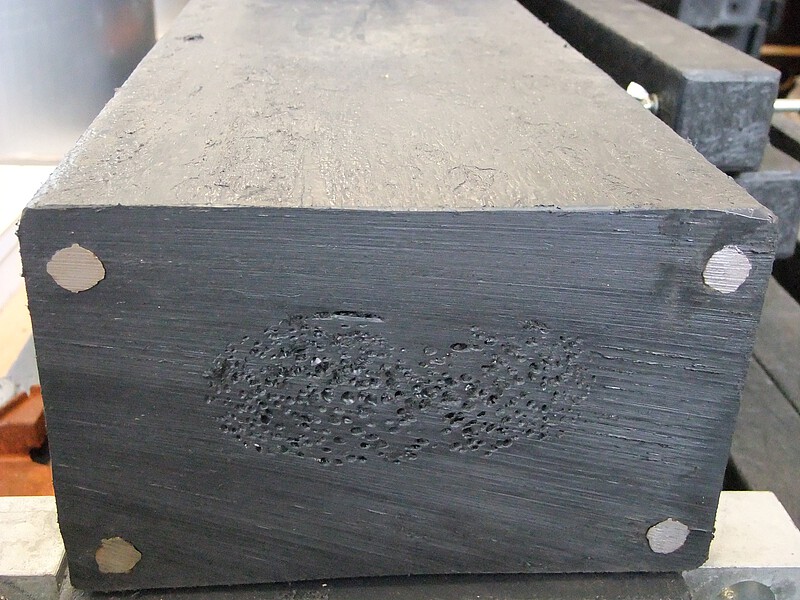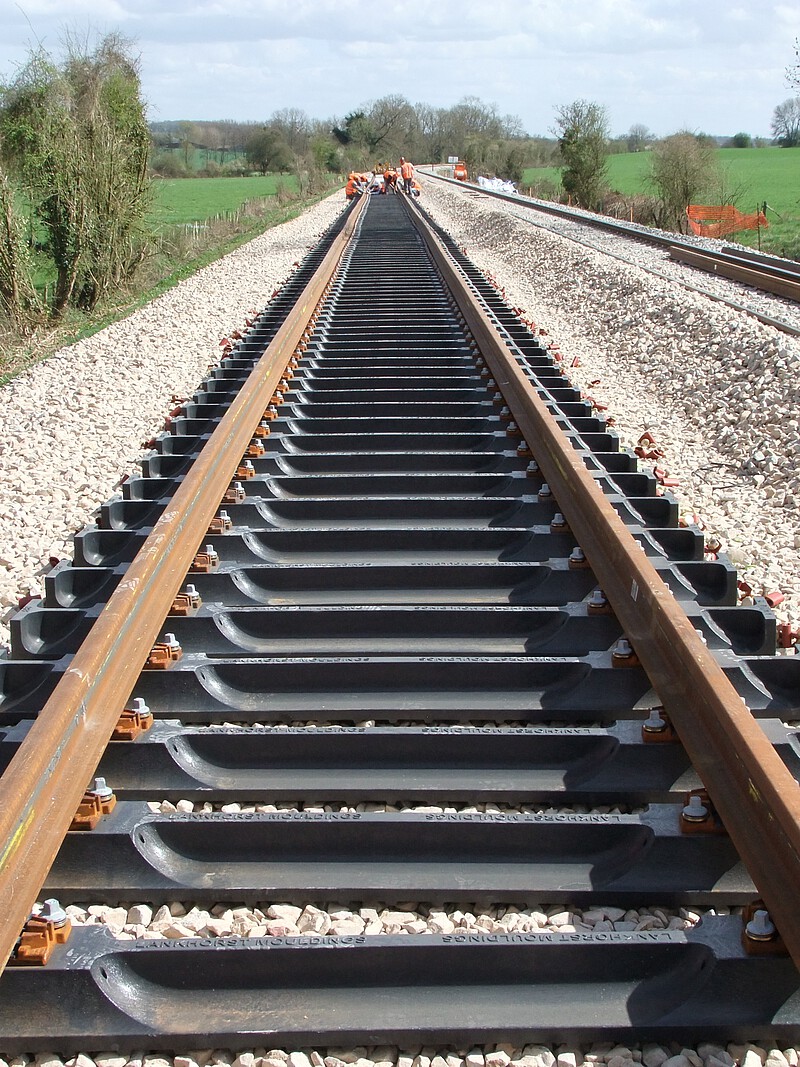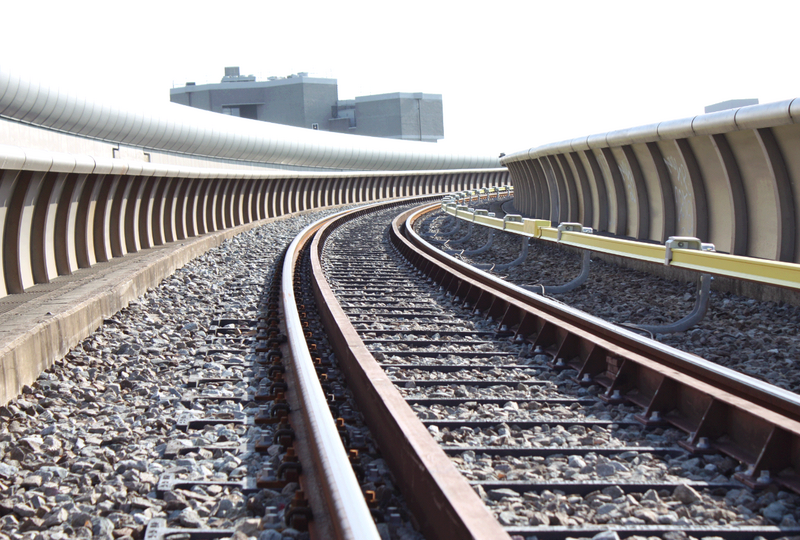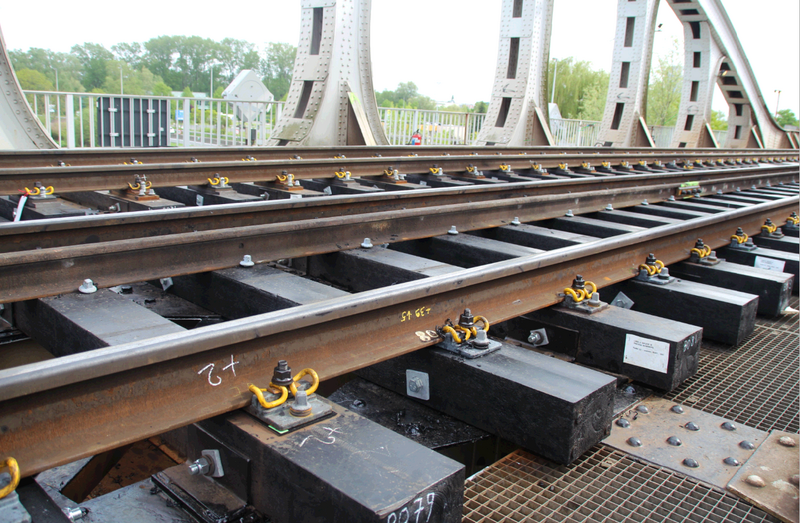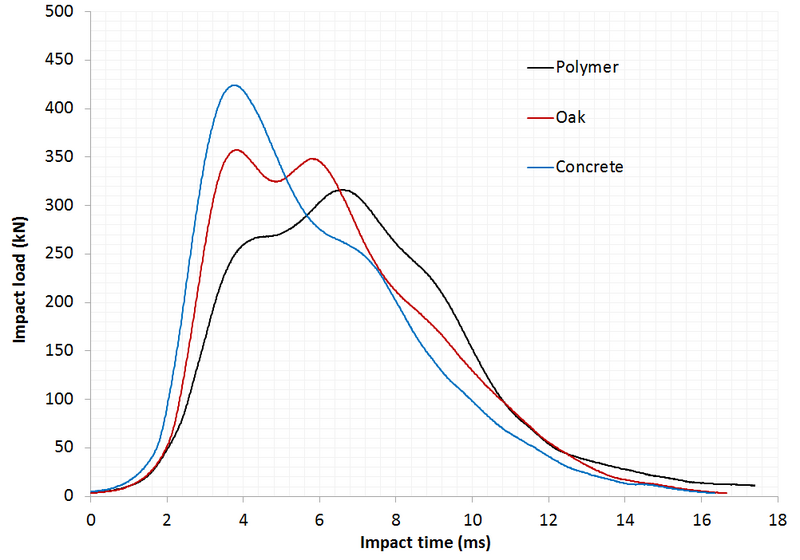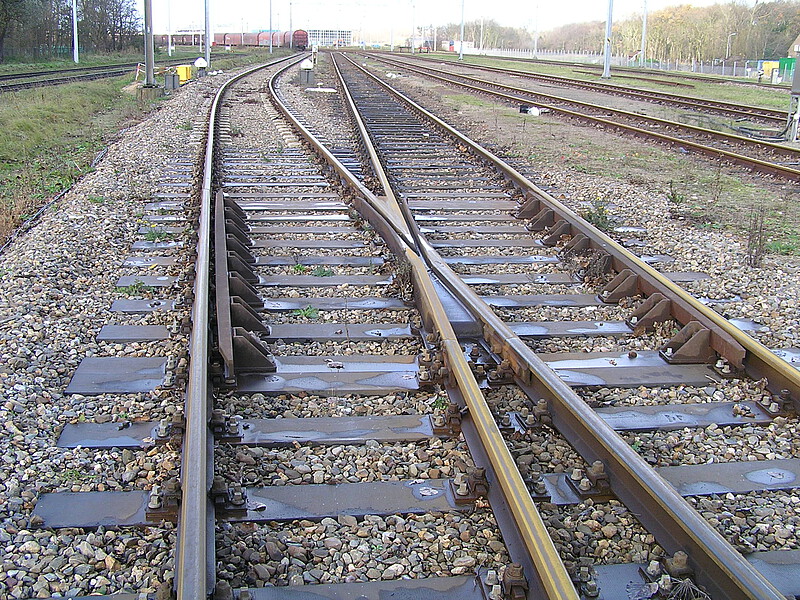Hybrid Polymer Sleepers
Hybrid Polymer Sleepers: a high-strength, environmentally-friendly sleeper for plain track, bridges, transition zones, and switches & crossings
Since the start of railways, millions of timber sleepers / ties have been installed all over the world. However, in order to preserve them, they require treatment with creosote, which is known for having a negative environmental impact when it leaches into the soil and ground water, and also for having carcinogenic effects. For this reason, as of 2018, the use of creosote is forbidden in a number of countries in the European Union. In The Netherlands, it has already been forbidden since 2005. The use of tropical hardwood, also known for having a negative environmental impact (deforestation), offers no real alternative, as its availability is decreasing. However, there are sleepers / ties made from 100% recycled polymers that offers a sustainable and maintenance-free alternative to timber sleepers, which have already been installed in a number of countries around the world. Hybrid Polymer Sleepers / Ties combine the consistency and durability of concrete sleepers / ties with the favourable damping behaviour of timber sleepers / ties.
Polymer by itself has a bending stiffness and a thermal expansion coefficient that does not make it suitable for use as sleeper / tie material. This can be overcome by reinforcing the material, for instance, by adding glass fibres, thus creating a glass-fibre reinforced composite sleeper / tie. However, it can also be reinforced by embedding discrete reinforcing elements, such as steel or glass-fibre bars – the sleepers / ties are then referred to as hybrid polymer sleepers / ties, in order to distinguish them from glass-fibre reinforced composite sleepers. Hybrid Polymer Sleepers / Ties have four reinforcing steel bars, i.e. one in each corner.
The main technical difference between composite sleepers / ties and hybrid polymer sleepers / ties lies in the fact that when reinforcing a polymer sleeper / tie with glass fibres, i.e. in the case of the composite sleeper / tie, the sleeper / tie is strengthened and stiffened more or less to the same degree throughout, resulting in a high bending stiffness, as well as a high compression stiffness. Also, by reinforcing the sleeper with glass fibres a more brittle material consistency is created.
Hybrid Polymer Sleepers / Ties, on the other hand, due to their discrete reinforcing elements (the four steel bars), do not have a brittle consistency and, thus, do not break or tear under load – as has been confirmed by extreme overload bending testing of the Hybrid Polymer Sleeper / Ties; in the case of a glass-fibre reinforced composite sleeper / tie, due to the brittleness of its material, the outcome may well have been different. Thus, Hybrid Polymer Sleepers / Ties would be well suited for strength and impact critical applications, such as on bridges, in locations where the ballast bed does not provide sufficient elasticity, as well as in locations that are subject to very high horizontal or vertical impact forces resulting from high-speed or high axle-load traffic loading. They are also ballast-friendly.
High lateral and vertical stability of Hybrid Polymer main track sleepers / ties for plain track
Hybrid Polymer main track sleepers / ties for plain track offer a high resistance to both lateral and longitudinal displacement due to its specially-designed bottom profile. Moreover, the sleeper / tie for plain track also features a recessed design, using up to 30% less material than a solid sleeper / tie, which allows the sleeper to be completely embedded within the ballast; this provides a high level of vertical stability against uplift, thus making the track “solid as a rock" and this sleeper ideal for use in places where a large lateral pressure is exerted on the track (e.g. in sharp curves), or where high vertical forces are exerted on the track (e.g. on bridges, viaducts or fly-overs).
Areas of application
Besides for plain track, the Hybrid Polymer Sleeper / Tie can be used for:
· Bridges.
· Transition zones.
· Switches & crossings.
· Areas where ballast fouling is an issue, e.g. in desert, mining or industrial areas.
as well as urban areas, and those with extreme hot or cold climatic conditions.
Bridges
Hybrid polymer sleepers / ties feature very favourable damping properties, making them suitable for application in areas where the ballast does not provide sufficient elasticity, such as in the case of a reduced ballast thickness, or when there is no ballast present at all, e.g. on steel girder bridges.
Ideally, on steel girder bridges, the load structural deflection on the bridge section of the track should be similar to that on the ballasted section. However, as there is no ballast present on steel girder bridges, this deflection is lacking and, due to the resultant high track stiffness, the sleepers / ties and the structure underneath are subjected to high impact loading. Therefore, in order to compensate for the lack of ballast compression, a sleeper / tie has to be used that offers a high compression flexibility, thus ensuring that the track stiffness on the bridge section is the same as on the ballasted section. Because of their rigidity and brittleness of material, the use of concrete sleepers / ties may not really be suitable. In such situations, hybrid polymer sleepers could offer a solution. These can be designed to create the specific track stiffness required and can be used for:
· Steel girder bridges where the bridge girder is located directly under the rail: in this case, compression stiffness is the determining parameter.
· Steel girder bridges where there is an offset between the rail and the bridge girder: in this case, high bending moments may occur in the sleeper / tie and thus, both bending stiffness and compression stiffness are the determining parameters. Usually hardwood sleepers / ties of considerable dimensions are used in the case of such bridges. However, as noted earlier, the availability of hardwood is decreasing and, thus, an alternative solution is needed, which could well be offered by hybrid polymer sleepers, as they have a high strength and favourable stiffness characteristics. They also offer dual safety, in that the steel bar reinforcement is not added to provide additional strength, but additional stiffness. The polymer itself, although strong enough to be used as sleeper material, does not have the required bending stiffness and, thus, the steel bars are added. Since the steel bar reinforcement and the polymer are both strong enough by themselves to create the desired product safety, failure of either of these elements will not lead to sleeper / tie failure (dual safety), but only to an increase in deflection. As noted earlier, hybrid polymer sleepers / ties do not have a brittle material consistency; therefore, they do not break or tear when subjected to a high loading.
In both cases, the adoption of flexible rail pads could also provide the track stiffness required. However, it is known that when using flexible rail pads, the noise emission from the rail may increase, since the rotational fixation of the rail is limited. When using hybrid polymer sleepers / ties, this rotational fixation is maintained whilst, at the same time, the track stiffness required is achieved. Measurements conducted on a steel girder bridge in The Netherlands yielded a 3-5 dB noise reduction following the replacement of timber sleepers / ties for hybrid polymer ones.
Transition zones
In transition zones, changes in track stiffness may occur and, thus, a difference in load distribution onto the sleepers / ties. In the graph, wheel load distribution in general is shown, whereby the wheel is located over sleeper / tie 0 – as can be observed, about 30-35% of the wheel force is distributed onto this sleeper / tie, and the remainder equally onto the sleepers located on either side of it. When a train crosses a bridge or a viaduct, a completely different picture emerges .
As can be observed from the graph, in the transition zone where 0 is the first sleeper on the bridge, some 60% of the wheel force is distributed onto this sleeper / tie, and there is an uneven load distribution onto the sleepers / ties located on either side of it - this is due to the lack of elasticity otherwise provided by the ballast. Such a large change in track stiffness is to be avoided. Hybrid Polymer Sleepers / Ties, which can be designed to create the specific track stiffness required, can offer a solution in such situations.
Switches& crossings
In switches & crossings, sleepers / ties may be subjected to high lateral accelerations and impact forces. In the graph, the different effects of impact loading on concrete, timber (oak) and polymer sleepers / ties is shown.
As can be observed from the graph, in the case of timber sleepers / ties, and even more of polymer ones, the effect of impact loading is distributed more over time than in the case of concrete sleepers / ties, this is due to the more favourable damping properties of both timber and polymer, whereas concrete is a rather rigid material.
The use of Hybrid Polymer Sleepers / Ties which, due to the high elasticity provided by the ductile polymer material they are made from, provide good damping properties, could offer a very suitable alternative for use in switches & crossings, they can easily be installed in-track – and drilled and milled like wood, unlike concrete sleepers / ties, which require every bolt hole (dowel) to be pre-cast in the factory. Furthermore, Hybrid Polymer Sleepers / Ties are available in a specially-designed connectable version that allows them to be joined together to produce a long sleeper (up to 10.4m), which can easily installed in locations with a limited working space, without requiring the digging of deep holes. Once installed, these sleepers / ties provide a constant bending stiffness throughout their entire length.
Ballast-fouling by sand - desert areas
As noted earlier, sleepers / ties made of concrete are rather rigid. In a ballasted track, the elasticity provided by the ballast bed compensates for this rigidity. However, when the ballast is fouled by, for instance, coal dust or sand, this elasticity will be reduced, resulting in large differences in the bedding modulus of the track. Therefore, in a concrete-sleepered track, where nearly all elasticity is provided by the ballast bed, any loss of elasticity due to ballast fouling leads to a significant increase in impact loading, which may result in a premature failure of the concrete sleeper / tie. In the case of hybrid polymer or timber sleepers / ties, there might also be some loss of elasticity that would lead to an increase in impact loading but, due to their favourable compression stiffness not to an extent that would lead to sleeper / tie failure.
In desert areas, the use of concrete sleepers / ties may also face other problems. For instance, in some cases, within the first few months following installation, micro-cracking and breakages may occur. The salt that is contained by the sand may seep into the steel reinforcement of the concrete sleeper / tie, causing it to corrode which, in turn, may lead to cracks in the concrete, and even breakages and, thus, a premature failure of the sleeper / tie. Hybrid Polymer Sleepers / Ties, due to their material consistency and high resistance to moisture, acids and salts, would not have this problem. Furthermore, they can be designed in such a manner that their geometry would slow down the process of sand accumulation between the rails, such as shown in the picture.
In friendly cooperation with Lankhorst Rail.

